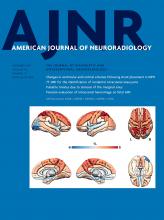Research ArticleAdult Brain
Idiopathic Intracranial Hypertension is Associated with a Higher Burden of Visible Cerebral Perivascular Spaces: The Glymphatic Connection
O. Jones, J. Cutsforth-Gregory, J. Chen, M.T. Bhatti, J. Huston and W. Brinjikji
American Journal of Neuroradiology December 2021, 42 (12) 2160-2164; DOI: https://doi.org/10.3174/ajnr.A7326
O. Jones
aFrom the Departments of Radiology (O.J., J.H., W.B.)
J. Cutsforth-Gregory
bNeurology (J.C.-G., J.C., M.T.B.)
J. Chen
bNeurology (J.C.-G., J.C., M.T.B.)
cOphthalmology (J.C., M.T.B.), Mayo Clinic, Rochester, Minnesota
M.T. Bhatti
bNeurology (J.C.-G., J.C., M.T.B.)
cOphthalmology (J.C., M.T.B.), Mayo Clinic, Rochester, Minnesota
J. Huston
aFrom the Departments of Radiology (O.J., J.H., W.B.)
W. Brinjikji
aFrom the Departments of Radiology (O.J., J.H., W.B.)

References
- 1.↵
- 2.↵
- 3.↵
- 4.↵
- Lenck S,
- Radovanovic I,
- Nicholson P, et al
- 5.↵
- 6.↵
- Mollan SP,
- Ali F,
- Hassan-Smith G, et al
- 7.↵
- 8.↵
- 9.↵
- 10.↵
- 11.↵
- 12.↵
- Morris PP,
- Black DF,
- Port J, et al
- 13.↵
- Friedman DI,
- Liu GT,
- Digre KB
- 14.↵
- Boespflug EL,
- Simon MJ,
- Leonard E, et al
- 15.↵
- Chabriat H,
- Joutel A,
- Dichgans M, et al
- 16.↵
- Cordonnier C,
- Al-Shahi Salman R,
- Wardlaw J
- 17.↵
- Doubal FN,
- MacLullich AM,
- Ferguson KJ, et al
- 18.↵
- 19.↵
- Joutel A,
- Faraci FM
- 20.↵
- 21.↵
- 22.↵
- 23.↵
- Wardlaw JM,
- Smith C,
- Dichgans M
- 24.↵
- 25.↵
- Mestre H,
- Kostrikov S,
- Mehta RI, et al
- 26.↵
- Iliff JJ,
- Wang M,
- Liao Y, et al
- 27.↵
- 28.↵
- 29.↵
- Yamamoto Y,
- Ihara M,
- Tham C, et al
- 30.↵
- 31.↵
- 32.↵
- Zhu YC,
- Tzourio C,
- Soumare A, et al
- 33.↵
- 34.↵
In this issue
American Journal of Neuroradiology
Vol. 42, Issue 12
1 Dec 2021
Advertisement
O. Jones, J. Cutsforth-Gregory, J. Chen, M.T. Bhatti, J. Huston, W. Brinjikji
Idiopathic Intracranial Hypertension is Associated with a Higher Burden of Visible Cerebral Perivascular Spaces: The Glymphatic Connection
American Journal of Neuroradiology Dec 2021, 42 (12) 2160-2164; DOI: 10.3174/ajnr.A7326
0 Responses
Idiopathic Intracranial Hypertension is Associated with a Higher Burden of Visible Cerebral Perivascular Spaces: The Glymphatic Connection
O. Jones, J. Cutsforth-Gregory, J. Chen, M.T. Bhatti, J. Huston, W. Brinjikji
American Journal of Neuroradiology Dec 2021, 42 (12) 2160-2164; DOI: 10.3174/ajnr.A7326
Jump to section
Related Articles
- No related articles found.
Cited By...
- Precise perivascular space segmentation on magnetic resonance imaging from Human Connectome Project-Aging
- Biological sex and BMI influence the longitudinal evolution of adolescent and young adult MRI-visible perivascular spaces
- Diffusion-Weighted Imaging Reveals Impaired Glymphatic Clearance in Idiopathic Intracranial Hypertension
- Glymphatic System in Ocular Diseases: Evaluation of MRI Findings
This article has not yet been cited by articles in journals that are participating in Crossref Cited-by Linking.
More in this TOC Section
Similar Articles
Advertisement











